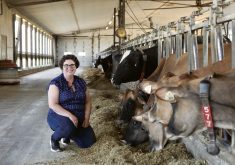“When the human mind is stretched, it never returns to its original size — similar to most new underpants.”
That’s a quote from the International Farm Management Congress in Scotland last year, and it’s one that Farm Management Canada (FMC) executive director Heather Watson uses to stress the enduring impact of continuous lifelong learning.
“The main trait that connects Canada’s top 25 percent of farmers is a lifelong commitment to learning,” adds Ashley Honsberger, executive director of Agri-Food Management Institute (AMI).
AMI and FMC teamed up with Ipsos Agriculture and Animal Health to produce 2016’s Dollars and Sense study to measure the tangible impacts of beneficial business practices on Canadian farms.
Read Also

Riding the tariff rollercoaster
Farmers are accustomed to roller-coaster years. But the current geopolitical windstorm is something else entirely. On his cattle operation near…
“A commitment to learning means that the business owner is able to continually adapt to a changing environment, which in agriculture is constant,” says Honsberger. “They’re able to better plan for change, and weather the ups and downs of markets.” Watson, however, notes only 49 per cent of the study’s surveyed producers were committed to lifelong learning.
“Farmers should always be thinking, ‘How do our skills meet the current and future needs of the farm,’” Watson says.
Assess and evaluate
The skills and tools required to run a modern farm differ greatly from those of the past, and they’ll keep changing over time as the industry and business landscape change, Watson says.
All the research that’s gone into determining the skills required to run today’s top farms — and there’s been a lot — has found the success of any farm enterprise, regardless of size, geography, or commodity is directly related to the farm business management skills and practices of the farm manager.
That makes assessing and evaluating the current skills and tools of farm operators key to managing a successful farm business.
“It allows you to take time to look at what went well and what could have gone better, so that you can put measures in place to improve,” Watson says.
“There are plenty of tools around — from business score cards to management proficiency tests — to help identify where you want to focus your energy and time, where you need others to be supporting you, and the opportunities for skills development to strengthen the farm team as a whole,” says Watson.
Assessment and evaluation tools designed for farm businesses can be accessed at www.pledgetoplan.ca.
One helpful exercise is to create an organizational chart that outlines all of the main positions on the farm and where everyone is situated. A farm team meeting could benefit the discussion.
“Do you have job descriptions for all of these positions, including core competencies and experience requirements?” asks Watson. “Job descriptions are a very important step in addressing the requirements of the farm and its people.”
Job descriptions also assist in recruiting the right people to fill the right positions, and otherwise address opportunities to progress through skills development, she says.
Manage your people and your business
Human resources might have once been the exclusive domain of city offices, but no longer.
“One thing we’ve noticed is that as a business grows, there is definitely a need for more skills in areas like human resource management,” says Honsberger. She explains that making a farm a great place for people to work and becoming an employer of choice in your area will pay off in the long run. Instead of dealing with constant turnover and downtime, you will have a consistent and well-trained team.
“Farmers we’ve encountered are up to the challenge of growing as managers, and even empowering their staff to become supervisors by using various management technologies and sharing information,” says Honsberger.
Concurrently, operators need to keep up with the dollars and cents side of their businesses.
“Now more than ever it is really important to know where the farm business is at financially and risk wise,” Honsberger says.
She explains business management is all about proactively preparing for change. The better equipped farmers are with management skills, the easier it is for them to make quick decisions that work for the betterment of their business.
Farmers can rely on an accountant or a business adviser in areas they don’t feel as strong in, but they can also learn more about the management side themselves through online resources, such as the ones AMI has developed.
They can also attend in-person workshops, which tend to encourage peer-to-peer learning.
“Government has taken an interest in investing in the management skill set of farmers, and that shows through the resources and programs that have been developed over the years,” Honsberger says. “Truly the better equipped that farmers are on the management side, the more resilient the agriculture sector is as a whole.”
Developing new skills
Improving skills on the farm can come from developing new processes like standard operating procedures or even adopting new technology such as software or equipment. But too often, farm owners overlook the opportunities that arise from investing in skills development, says Watson.
She encourages farmers to consider creating a skills development plan and making it part of an overall business plan, adding it’ll serve the farm well, helping create a team whose members are empowered to contribute to the farm in their own unique and recognized ways.
Learning opportunities abound post-harvest, with conferences, workshops and various industry meetings staged throughout the winter months. Think about which events provide the best learning opportunities for you and your farm team.
“I encourage everyone to attend learning-focused events,” says Watson. “Or consider enrolling in the only national farm business skills development program for farmers, the Canadian Total Excellence in Agricultural Management (CTEAM) program, starting in December.”
She stresses the importance of creating a culture of lifelong learning. When members of a farm team have had a chance to gain knowledge and develop their skills, host a farm team meeting to share what they learned and their insights.
“Demonstrate how investing in skills development is invaluable to the farm to endorse continuous learning on the farm,” Watson says.
Farm partners
In Honsberger’s experience, farm partners tend to stick to their own areas of expertise. It’s what they’re good at and they feel comfortable relying on their partner to take care of their end.
But what works best is when partners work together to share information, she says. “It allows for better analysis for things like cost management and also offers more strategic thinking about investments, and about the farm as a whole,” Honsberger says.
She sees things heading toward a broader knowledge base being developed, such as strategic marketing as part of the cost of production process to ensure the sell price aligns with the farm’s overall income goals.
“Even if one family member is wholly responsible for the bookkeeping, it’s important to have regular meetings with the person in charge of purchasing and investments so that the cash flow is managed effectively,” Honsberger says.
Next generation
Assessment and evaluation aren’t one-time-only steps, and need continual reconsideration as time passes and situations change. “Think of the farm in five, 10 years: does the organizational chart remain the same, or will it change?” asks Watson. “What happens if the farm expands? Are new positions required? New skills? Does this mean new hires or upgrades for existing team members?”
This reassessment and re-evaluation becomes particularly important when preparing for offspring returning to the farm. Parents will have to ask themselves if their sons and daughters have the right skills, and if they’ll ably contribute to the growth and profitability of the farm, Honsberger says.“Try to be objective — would you hire them, even if they weren’t family?”
Honsberger says offspring can be tasked with finding innovative or more efficient ways to increase revenues so the operation can financially absorb their return.
“So they start thinking about value-added opportunities, new enterprises like a machine shop, or working off farm,” she says.
As the family business system evolves, the roles and responsibilities of sons and daughters are often divided based on interest and aptitude, and the growing needs of the operation overall. Some parents might encourage their offspring to take on the business side of things like marketing, bookkeeping or business management.
And additional education isn’t out of the question for the returned college graduate.
“There is definitely a leap between what was learned in class and the realities of running a farm,” says Honsberger. “So programs like our Advanced Farm Management try and offer a reminder of the skills they may have learned in class, and apply them to a real scenario, being their own farm. Both generations can definitely benefit from ongoing learning about the various management areas.”
















